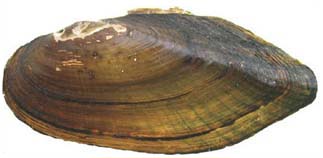Eastern Pondmussel
Ligumia nasuta
 NH Conservation Status: State threatened
NH Conservation Status: State threatened
NH State Rank Status: Critically imperiled (global – apparently secure)
Distribution: Restricted to coastal ponds in the Coastal and Merrimack River watersheds. During 2010, Eastern pondmussel were found in six ponds: Cobbetts Pond (Windham), Little Island Pond (Pelham), Country Pond (Kingston/Newton), Great Pond (Kingston), Wash Pond (Hampstead), and Powwow Pond (Kingston). There is a record in Golden Brook but they were not detected during 2010 surveys. There is one historic record from the Ashuelot River (Connecticut River watershed).
Description: A large elongate mussel growing up to 6 inches with a blunt point on one end. Shell color ranges from yellowish-brown or greenish to brownish-black. The inner shell (nacre) is usually silvery white or pinkish.
Commonly Confused Species: Eastern elliptio
Habitat: Coastal ponds and slow-moving streams and river. Found in a variety of substrates.
Life History: Host fish not yet determined, possibly anadromous species; information on distribution and abundance still needed.
Conservation Threats: Major threats include habitat degradation, pollution, and lake management. Although identified as ‘apparently secure’ globally (NatureServe 2012), the species is ranked as vulnerable to critically imperiled in every state that it occurs. In NH, the species is not currently legally protected as endangered or threatened. However, recent surveys indicate that the status of the species may warrant further review. Of the 6 ponds where eastern pondmussels are currently known, only one (Wash Pond) has had robust densities detected to date. Many ponds and lakes in southern New Hampshire are highly managed for a variety of uses. Some management activities, such as severe lake drawdowns, could negatively affect this and other benthic organisms (animals that live on the bottom/substrate of the lake) that are unable to move rapidly. Other activities such as shoreline development and vegetation management could also pose a threat but have not received adequate attention and study.



